 |
There seems to be an aversion to allowing children to use their fingers in maths. This is pity because they are a very good tool for use in counting and learning maths especially in the early stages. If it is OK to press them against calculator keys or computer key boards why can they not be used as tally sticks or as a calculating devise. The Japanese abacus the soroban has four lower and one upper bead per rod, since 1920, just like a hand. The hands can be made to act just like an abacus. Hands don't take much time to boot up, nor do the batteries go flat and hopefully you always have them with you. |
| Here is a simple way to go from knowing the five times table to the 9 times tables. After a while using this technique the 6 to 9 tables will be come known with out all the effort of reciting them parrot fashion, which lacks any instinctive feel for the numbers. |
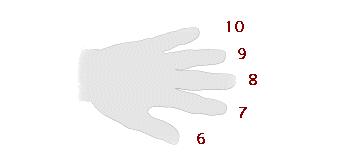 |
Count from the thumb(the thumb is here a finger) upwards starting with the thumb as 6 Now to multiple any two number from 6 to 10 touch the two hands together with the fingers on one hand representing one of the numbers with the fingers of the other hand representing the other number. 8 x 8 would mean touching the two middle finger together. Then add the all the fingers from the thumb to those fingers touching. These are the tens. Multiple the remaining fingers on one hand by the reaming fingers of the other. This is the units |
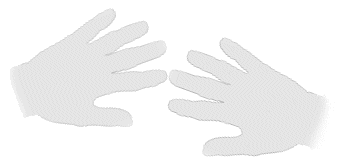 |
To multiple 7 x 8 Count from the thumb upwards the number of digits on both hands 2 + 3 = 5 Now multiple the remaining fingers on each hand 2 x 3 = 6 which gives the answer 56 |
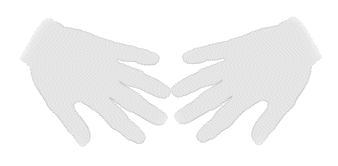 |
To multiple 9 x 9 Count from the thumb upwards the number of digits on both hands 4 + 4 = 8 Now multiple the remaining fingers on each hand 1 x 1 = 1 which gives the answer 81 |
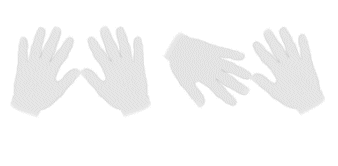 |
Now try these two. 6 x 6 and 6 x 9. Note the additional step with the 6 x 6. |
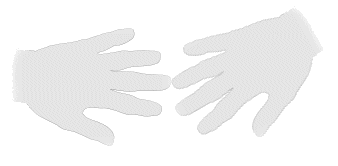 |
This method can be extended for both numbers greater then ten by touching the fingers with ten taken away. Shown 13 x 14 so adding 3 + 4 all times 10 becomes 7 x 10 = 70. Then multiple the lower fingers together 3 x 4 = 12 and add the two numbers together with 100, 70 + 12 + 100 = 182. However we would not suggest this method beyond single digit multiplication as easier methods exist. |
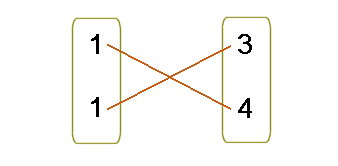 |
For such numbers we could use the method sometimes referred to as "vertically and crosswise". Too multiply 13 by 14. We multiply vertically 3 x 4 = 12. Put down 2 and remember the 1 to carry. Then we multiply crosswise and add the two results 1 x 4 + 1 x 3 = 7 add the 1 carry, so put down 8 with 0 to carry. Finally we multiply vertically 1 x 1 = 1 and put down the 1. This gives the result 182. |
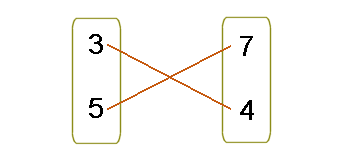 |
Similary for 37 x 54, first multiple verticaly 7 x 4 = 28 put down the 8 and carry the 2, multiply crosswise and add the two results, 3 x 4 + 5 x 7 + 2 (the carry) = 49. Put down the 9 and carry 4 finally 3 x 5 = 14 + 4 = 19 and put this down, which gives the results 1998. |
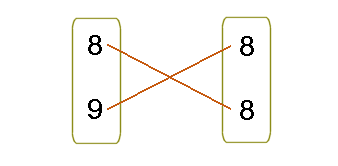 |
Here the simple form of "vertically and crosswise" gives some diffifcult numbers to hold in our head so we use a variation of it. Think of the numbers each requires to make them up to 100, these are 12 and 2 respectavily. Now take one of these numbers from the orther original number. In this case 88 - 2 or 98 - 12 which gives 86. Write this number down and then multiple the two numbers that make the 100s, 12 x 2 and write this down after the first number. This gives the answer 8624. |
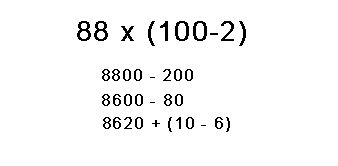 |
However 88 x 98 is really a calculation one should just be able to write down in a second or two with hardly any calculations at all. This is the same as 88 x 100 less 88 x 2. Which left to right is 16 + 1 because the second number is greater then 4 so think 17 and then the number beyond 10 that 8 x 2 is which is 6 giving 176. This assumes one can't see automatically that 88 x 2 = 176. Now 88 x 100 = 8800 so right to left put down 8. 176 to the next highest 100 is 200 so the next number to put down is 8 - 2 = 6, 76 to the next highest 10 is 80 so 0 - 8 is 2 (mentally add the 10) so put down the two. Finally put down the number that makes the 6 (of 176) up to 10 = 4. This gives the result 8624. This way one is normaly only using numbers 0 to 9. |
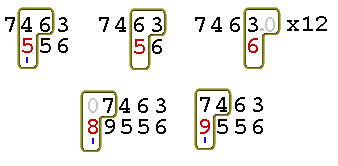 |
There are alternate ways to multiple by numbers for instance to multiple by 12 without recourse to the twelve times table, although we recommend strongly that all the tables should be learnt up to 10. To multiply a longish number by twelve simply double each individual number by two and add it to its' right hand neighbour. Starting with the top right hand set of numbers take 3 and double it = 6 add to it right neighbour which is effectively zero giving six. Put this down under 3. The next set is 6 x 2 = 12 + 3 = 15 put down the 5 and put a carry below the next number. The next set is 4 x 2 = 8 + 6 plus the carried 1 = 15 put down the 5 and put a carry below the next number. Continuing on the lower line. The next set is 7 x 2 = 14 + 4 plus the carried 1 = 19 put down the 9 and put a carry below the next number. There is an additional set where the number to double is zero so this is 0 x 2 + 7 plus the carried 1 = 8 so put this down. This then is the answer 89556. |